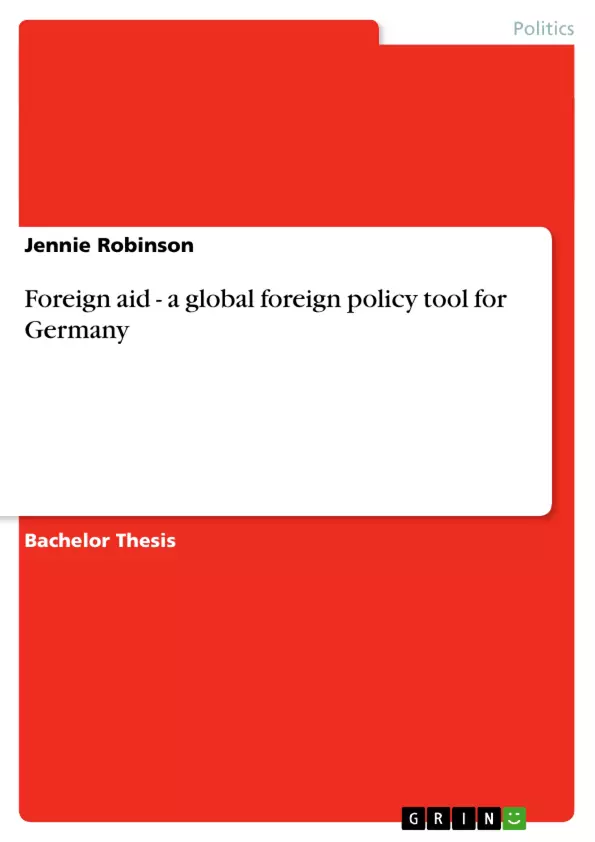In global affairs, the issue of poverty alleviation has intensified the question over foreign aid. Both the North and the South have their responsibilities in allowing the gap between them to widen, and this global issue worsening. However, dominant countries are able to dictate and influence international relations so as to enhance their interests. Less powerful countries on the other hand remain in a dependent position, having little choice but to accept the conditions set, while they also seek to secure their interests.
In the context of this paper, the aim is to illustrate how foreign aid to Africa has been a global foreign policy tool for Germany. Foreign aid has allowed the growth of German markets for its exports, and thus boosting its economic status at a global level. Foreign aid has also provided employment for those working in the international development cooperation sector. Hence by becoming a powerful economic player, Germany has also gradually increased its status as a global political player. Within the context of global security challenge, foreign aid has also been used as a global foreign policy tool in the context of fighting poverty and the promotion of democracy under the banner of good governance. Foreign aid has also helped in promoting local projects in the developing countries, where for instance German environmental expertise remains necessary. However, the poverty plight has worsened over the last decades, and this thus questions the use for foreign aid. Radical critics argue that it has not been effective in developing Africa but rather contributes to its continuous dependency and hinders genuine economic development. And it has been sadly furthering the process of poor subsidizing the rich through the South-North flows. Ultimately, only time may improve the situation of global inequality, through all ongoing projects. The North-South gap however ultimately seems to have become a spiraling cycle with foreign aid considered the ultimate cure for all ills of the South. However, a status quo has been established in the global economy and it would be difficult and would take a long time to change it. Any recommendation would therefore be for fairer trade and the continuing efforts towards improving the situation in the South through sustainable projects with the environment as a major consideration.
Inhaltsverzeichnis (Table of Contents)
- O. Introduction
- I. Foreign Policy, International Relations (IR) and Development Theories
- I. 1) Foreign Policy
- I. i) a. Foreign aid as a Foreign Policy Tool
- I. 2) IR Theories
- I.2) a. Constructivism
- I. 2) b. Utilitarian Liberalism
- I. 3) Development
- I. 3. 1) Development Theories
- I. 3. 2) Foreign Aid
- I.3.2) a. Foreign aid and Multilateralism
- II. German Foreign Policy and Development Aid
- II.1 IPE
- II.2 German Foreign Policy since Post-World War Two (WW2)
- II.3 German Foreign Aid Policy or Development Cooperation
- II.3.1 21st Century Challenge: From Development Aid to Poverty Alleviation
- II.3.1.a) Global Causes of Poverty
- II.3.2.b) Germany's Endeavour against Poverty
- II.3.2 21st Century Challenges: Global Good Governance
- II.3.3. 21st Century Challenges: Development Aid as a Global Foreign Policy Tool
- II.3.1 21st Century Challenge: From Development Aid to Poverty Alleviation
- III. Germany's Africa Policy
- III. a) German Democratic Republic (GDR)
- III. b) Federal Republic of Germany (FRG)
- III.1 Global Security Policy: Germany's Quest for Profile through its Africa Policy
- III.2 UN Millennium Development Goals (MDGs)
- III.3 Debt Relief
- III.3.1) Germany and Debt Relief
- III.4 Germany and the G8
- III.5) Germany and EU
- IV. Impact of (German) Foreign Aid to Africa
- IV.1 Germany and Environmental Policy
- IV.2 Germany's Country Concentration in Sub-Saharan Africa
- IV.2.1 Madagascar
- IV.2.2 Ethiopia
- IV.3 Africa and Foreign Aid: Reflecting Half a Century of \"Development Assistance\"
- IV. 3.1 Advocates of Foreign Aid
- IV. 3.2 Critics of Foreign Aid
- IV. 3.3 South-North Flows
- IV. 3.4 On the Road to End Foreign Aid
Zielsetzung und Themenschwerpunkte (Objectives and Key Themes)
This dissertation aims to illustrate how foreign aid to Africa has been a global foreign policy tool for Germany. It examines the ways in which foreign aid has benefited Germany economically and politically, and explores the impact of aid on the development of Africa.
- Foreign aid as a tool of German foreign policy
- The role of foreign aid in promoting German economic interests
- The relationship between foreign aid and global security
- The impact of foreign aid on the development of Africa
- Criticisms of foreign aid and its effectiveness
Zusammenfassung der Kapitel (Chapter Summaries)
The dissertation begins by defining the terms of foreign policy, international relations, and development. It then explores different IR theories and development theories in relation to foreign aid. Chapter II focuses on German foreign policy and development aid, examining the country's economic and political interests in providing aid. Chapter III analyzes Germany's Africa policy, highlighting the country's strategic approach to the continent. Chapter IV explores the impact of German foreign aid on Africa, examining its effects on the environment, economy, and political stability.
Schlüsselwörter (Keywords)
This dissertation focuses on the following keywords: foreign aid, development aid, international relations, foreign policy, German foreign policy, Africa, poverty alleviation, development, global security, economic interests, political influence, dependency, South-North flows, sustainable development.
- Citation du texte
- Jennie Robinson (Auteur), 2007, Foreign aid - a global foreign policy tool for Germany, Munich, GRIN Verlag, https://www.grin.com/document/91334



